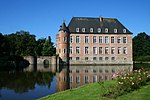Castle of Westerlo
This article needs additional citations for verification. (June 2022) |
On the territory of the municipality of Westerlo (Westerloo, using the old spelling) there are several castles.
Castle of the Princes de Mérode

Locals call it "Oud Kasteel" (Old Castle) (51°05′02″N 4°55′02″E / 51.08399°N 4.917347°E) to discern it from the new castle built for Jeanne de Merode in 1910-12 (see below). The castle has been the home of the
The sumptuous interiors contain fine furniture, paintings, tapestries, Córdoba leather wall hangings and objects collected by the Merode family throughout the centuries. The most important rooms like the entrance hall, the "ridderzaal" (knight's hall), the large drawing room, the dining room and the chapel can be visited during the 'Kasteelfeesten' in the first weekend of July.

An
Castle of Countess Jeanne de Mérode

Locals call it "Nieuw Kasteel" (New Castle) (51°05′25″N 4°54′44″E / 51.090245°N 4.912321°E). It was built between 1909 and 1912 in a
From 1909 onwards, the vast castle was constructed hardly a kilometre away from her paternal residence. The architecture of the facades was inspired by the early 16th-century late Gothic wing of the nearby abbey of Tongerlo. A more aristocratic appearance was achieved by adding four small and one large tower, as well as a bell tower in the form of a crown. Although both interior and exterior were executed in a historical style, the building contained many modern features that were very rare on the countryside at the beginning of the 20th century. The cross-beams supporting the roof were in steel, and the building had electric lighting, an electric elevator, central heating, running water, WCs and bathrooms.
As Jeanne de Mérode was very devout, the Castle also had its own private
When German troops invaded Belgium in 1940 the castle was confiscated and used as a local headquarters by the Nazis. Countess Jeanne moved back to the 'old castle' of Westerlo where she died on 1 July 1944, a few months before the liberation of Belgium. She left the castle to a monastic order of sisters. The building was used by the church as a home for retired priests until it was sold to the municipality of Westerlo in the 1970s. It has served as the Town Hall of Westerlo ever since.
Castle of Baron de Trannoy
In nearby
Castle of the Naets family
Built in the 1920s by a wealthy family of notaries and local administrators.
See also
- List of castles in Belgium
Sources
- Evrard Op de Beeck,Vijfhonderd jaar familie de Merode te Westerlo, Heemskring Ansfried, Westerlo, 1982.
- Henri Vannoppen, Het kasteel van Westerlo en de Prinsen de Merode, Heemskring Ansfried, Westerlo, 1989.
- Kris De Winter, Westerlo, land van Merode, Heemkring Ansfried, Westerlo, 2000.




